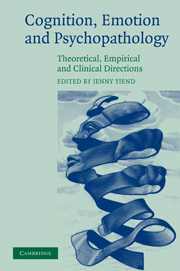An introduction and synthesis
Published online by Cambridge University Press: 23 November 2009
Summary
It will not escape the reader's notice that the inspiration for this volume is our friend and colleague, Andrew Mathews. It was my intention at the outset of the project to bring together a collection of researchers in the field of cognition and emotion who have been taught by, worked with or been heavily influenced by Andrew. The enthusiasm and readiness to participate that I encountered is testament itself to the high esteem in which Andrew is held, and this is also reflected in the many personal tributes scattered throughout the book. For those less familiar with Andrew's history, Tom Borkovec, a long-standing colleague and friend, provides a fascinating and more personal overview of Andrew's contributions to the field, from his clinically oriented early work, through his seminal findings and theorizing on cognitive biases, to his latest theory and present interests in the experimental modification of biased processing.
It is a tribute to the extent of Andrew's influence that contributors to this volume span a wide range of approaches. This is reflected in the structure of the book, which is organized around the scientific progression from theoretical conception, through experimental verification, to application in the clinic. These divisions are inevitably somewhat arbitrary, given that in this field most of us are typically concerned with all three domains. Indeed, some contributions would sit equally comfortably in any section. Thus, rather than being at all exclusive, the structure is instead intended to reflect authors' primary orientations towards the field, be it clinical, theoretical or empirical.
- Type
- Chapter
- Information
- Cognition, Emotion and PsychopathologyTheoretical, Empirical and Clinical Directions, pp. 1 - 7Publisher: Cambridge University PressPrint publication year: 2004



